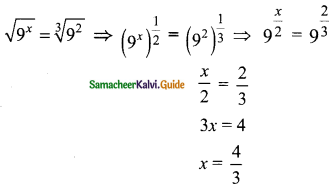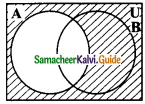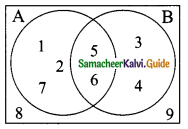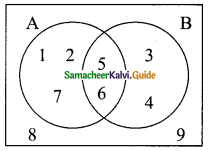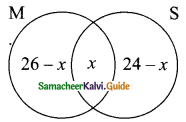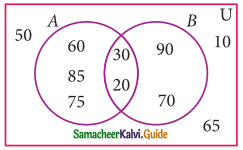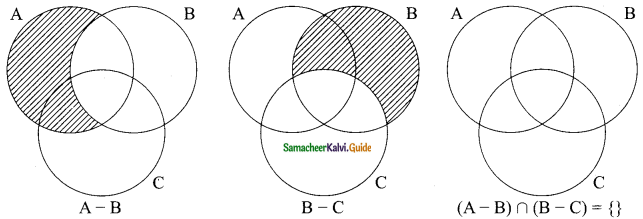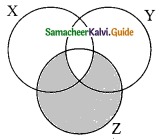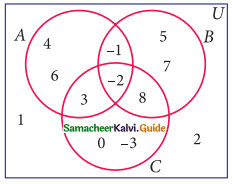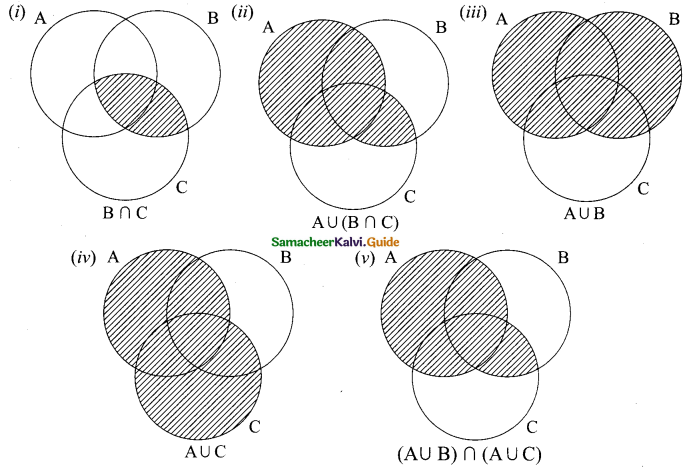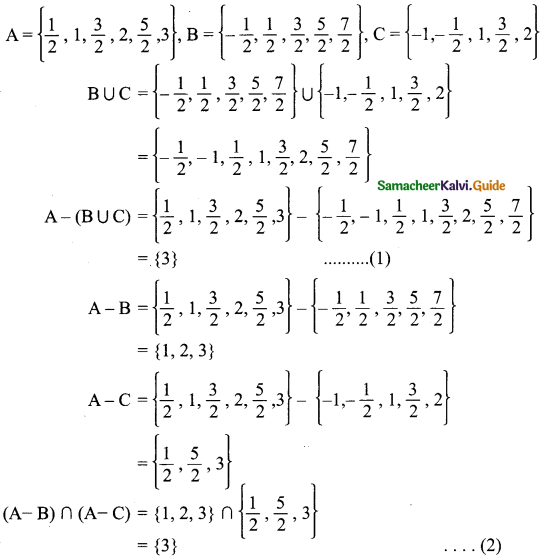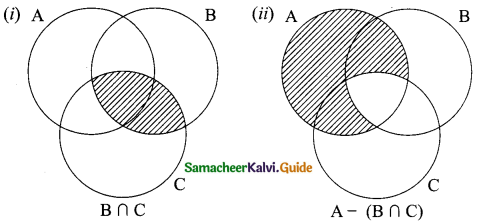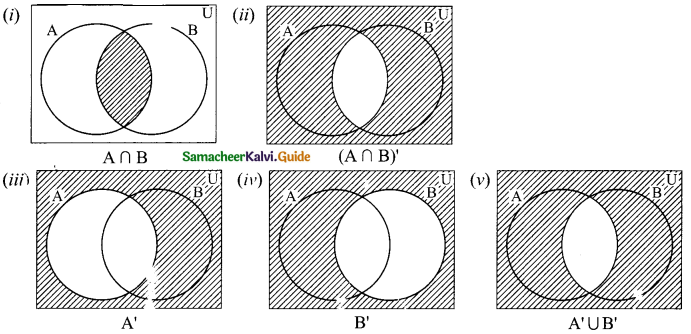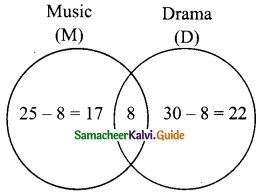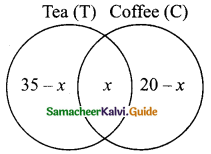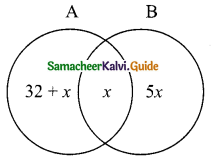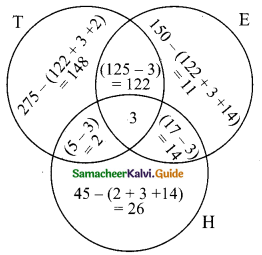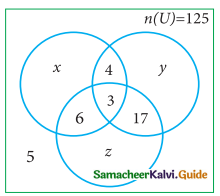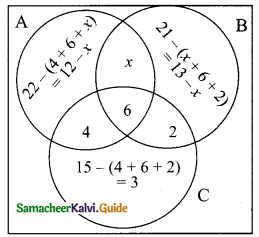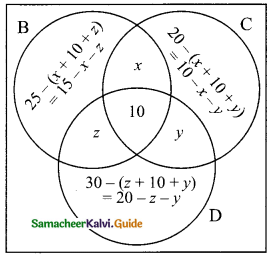Students can download Maths Chapter 3 Algebra Ex 3.1 Questions and Answers, Notes, Samacheer Kalvi 9th Maths Guide Pdf helps you to revise the complete Tamilnadu State Board New Syllabus, helps students complete homework assignments and to score high marks in board exams.
Tamilnadu Samacheer Kalvi 9th Maths Solutions Chapter 3 Algebra Ex 3.1
Question 1.
Which of the following expressions are polynomials. If not give reason:
(i) \(\frac{1}{x^2}\) + 3x – 4
Solution:
(i) \(\frac{1}{x^2}\) + 3x – 4 is not a polynomial. Since the exponent of x2 is not a whole number, but it is (\(\frac{1}{x^2}\) = x-2) negative number.
(ii) x2 (x – 1)
Solution:
x2 (x – 1) is a polynomial.
(iii) \(\frac{1}{x}\) (x + 5)
Solution:
\(\frac{1}{x}\) (x + 5) is not a polynomial. Since the exponent of x is not a whole number, but it is (\(\frac{1}{x}\) = x-1) negative number.
(iv) \(\frac{1}{x^{-2}}\) + \(\frac{1}{x^{-1}}\) + 7
Solution:
\(\frac{1}{x^{-2}}\) + \(\frac{1}{x^{-1}}\) + 7 is a polynomial. (\(\frac{1}{x^{-2}}\) = x2 and \(\frac{1}{x^{-1}}\) = x)
(v) √5x2 + √3x + √2
Solution:
√5x2 + √3x + √2 is a polynomial.
(vi) m2 – \(\sqrt[3]{m}\) + 7m – 10
m2 –\(\sqrt[3]{m}\) + 7m – 10 is not a polynomial. Since the exponent of m is not a whole number.
(\(\sqrt[3]{m}\) = m1/3)
![]()
Question 2.
Write the coefficient of x2 and x in each of the following polynomials.
(i) 4 + \(\frac{2}{5}\) x2 – 3x
Solution:
Coefficient of x2 is \(\frac{2}{5}\) and coefficient of x is -3.
(ii) 6 – 2x2 + 3x3 – √7x
Solution:
Coefficient of x2 is -2 and coefficient of x is -√7
(iii) π x2 – x + 2
Solution:
Coefficient of x2 is π and coefficient of x is -1.
(iv) √3x2 + √2x + 0.5
Solution:
Coefficient of x2 is √3 and coefficient of x is √2
(v) x2 – \(\frac{7}{2}\) x + 8
Solution:
Coefficient of x2 is 1 and coefficient of x is –\(\frac{7}{2}\)
![]()
Question 3.
Find the degree of the following polynomials.
(i) 1 – √2 y2 + y7
(ii) \(\frac{x^{3}-x^{4}+6 x^{6}}{x^{2}}\)
(iii) x3 (x2 + x)
(iv) 3x4 + 9x2 + 27x6
(v) 2√5p4 \(-\frac{8 p^{3}}{\sqrt{3}}+\frac{2 p^{2}}{7}\)
Solution:
(i) 1 – √2 y2 + y7
The degree of the polynomial is 7.
(ii) 
= x – x2 + 6x4
The degree of the polynomial is 4.
(iii) x3 (x2 + x) = x5 + x4
The degree of the polynomial is 5.
(iv) 3x4 + 9x2 + 27x6
The degree of the polynomial is 6.
(v) 2√5p4 \(-\frac{8 p^{3}}{\sqrt{3}}+\frac{2 p^{2}}{7}\)
The degree of the polynomial is 4.
![]()
Question 4.
Rewrite the following polynomial in standard form.
(i) x – 9 + √7x3 + 6x2
Solution:
The standard form is √7x3 + 6x2 – x – 9
(or) – 9 + x + 6x2 + √7x3
(ii) √2x2 – \(\frac{7}{2}\) x4 + x – 5x3
Solution:
The standard form is – \(\frac{7}{2}\) x4 – 5x3 + √2x2 + x
(or) x + √2x2 – 5x3 – \(\frac{7}{2}\) x4
(iii) 7x3 – \(\frac{6}{5}\) x2 + 4x – 1
Solution:
The given polynomial is in standard form (or) – 1 + 4x – \(\frac{6}{5}\) x2 + 7x3
(iv) y2 + √5y3 – 11 – \(\frac{7}{3}\) y + 9y4
Solution:
The standard form is 9y4 + √5y3 + y2 – \(\frac{7}{3}\) y – 11
(or) – 11 – \(\frac{7}{3}\) y + y2 + √5y3 + 9y4
![]()
Question 5.
Add the following polynomials and find the degree of the resultant polynomial
(i) p(x) = 6x2 – 7x + 2; q(x) = 6x3 – 7x + 15
Solution:
p(x) + q(x) = 6x2 – 7x + 2 + 6x3 – 7x + 15
= 6x3 + 6x2 – 7x – 7x + 2 + 15
= 6x3 + 6x2 – 14x + 17
The degree of the polynomial is 3.
(ii) h(x) = 7x3 – 6x + 1; f(x) = 7x2 + 17x – 9
Solution:
h(x) + f(x) = 7x3 – 6x + 1 + 7x2 + 17x – 9
= 7x3 + 7x2 + 11x – 8
The degree of the polynomial is 3.
(iii) f(x) = 16x4 – 5x2 + 9; g(x) = -6x3 + 7x – 15
Solution:
f(x) + g(x) = 16x4 – 5x2 + 9 – 6x3 + 7x – 15
= 16x4 – 6x3 – 5x2 + 7x + 9 – 15
= 16x4 – 6x3 – 5x2 + 7x – 6
The degree of the polynomial is 4.
![]()
Question 6.
Subtract the second polynomial from the first polynomial and find the degree of the resultant polynomial.
(i) p(x) = 7x2 + 6x – 1; q(x) = 6x – 9
Solution:
p(x) – q(x) = 7x2 + 6x – 1 – (6x – 9)
= 7x2 + 6x – 1 – 6x + 9
= 7x2 + 6x – 6x – 1 + 9
= 7x2 + 8
The degree of the polynomial is 2.
(ii) f(y) = 6y2 – 7y + 2; g(y) = 7y + y3
Solution:
f(y) – g(y) = 6y2 – 7y + 2 – (7y + y3)
= 6y2 – 7y + 2 – 7y – y3
= -y3 + 6y2 – 7y – 7y + 2
= -y3 + 6y2 – 14y + 2
The degree of the polynomial is 3.
(iii) h(z) = z5 – 6z4 + z; f(z) = 6z2 + 10z – 7
Solution:
h(z) – f(z) = z5 – 6z4 + z – (6z2 + 10z – 7)
= z5 – 6z4 + z – 6z2 – 10z + 7
= z5 – 6z4 – 6z2 + z – 10z + 7
= z5 – 6z4 – 6z2 – 9z + 7
The degree of the polynomial is 5.
![]()
Question 7.
What should be added to 2x3 + 6x2 – 5x + 8 to get 3x3 – 2x2 + 6x + 15?
Solution:
3x³ – 2x2 + 6x + 15 – (2x³ + 6x2 – 5x + 8)
= 3x³ – 2x2 + 6x + 15 – 2x³ – 6x2 + 5x – 8
= 3x³ – 2x³- 2x2 – 6x2 + 6x + 5x + 15 – 8
= x³ – 8x2 + 11x + 7
x³ – 8x2 + 11x + 7 must be added to get 3x³ – 2x2 + 6x + 15.
Question 8.
What must be subtracted from 2x4 + 4x2 – 3x + 7 to get 3x3 – x2 + 2x + 1?
Solution:
2x4 + 4x2 – 3x + 7 – (3x3 – x2 + 2x + 1)
= 2x4 + 4x2 – 3x + 7 – 3x3 + x2 – 2x – 1
= 2x4 – 3x3 + 4x2 + x2 – 3x – 2x + 7 – 1
= 2x4 – 3x3 + 5x2 – 5x + 6
2x4 – 3x3 + 5x2 – 5x + 6 must be subtracted to get 3x3 – x2 + 2x + 1.
![]()
Question 9.
Multiply the following polynomials and find the degree of the resultant polynomial:
(i) p(x) = x2 – 9, q(x) = 6x2 + 7x – 2
Solution:
p(x) × q(x) = (x2 – 9) (6x2 + 7x – 2)
= 6x4 + 7x3 – 2x2 – 54x2 – 63x + 18
= 6x4 + 7x3 – 56x2 – 63x + 18
The degree of the polynomial is 4.
(ii) f(x) = 7x + 2, g(x) = 15x – 9
Solution:
f(x) × g(x) = (7x + 2) (15x – 9)
= 105x2 – 63x + 30x – 18
= 105x2 – 33x – 18
The degree of the polynomial is 2.
(iii) h(x) = 6x2 – 7x + 1, f(x) = 5x – 7
Solution:
h(x) × f(x) = (6x2 – 7x + 1) (5x – 7)
= 30x3 – 42x2 – 35x2 + 49x + 5x – 7
= 30x3 – 77x2 + 54x – 7
The degree of the polynomial is 3.
![]()
Question 10.
The cost of a chocolate is Rs. (x + y) and Amir bought (x + y) chocolates. Find the total amount paid by him in terms of x and y. If x = 10, y = 5 find the amount paid by him.
Solution:
The cost of a chocolate = (x + y)
Number of chocolates bought by Amir = x + y
Total amount paid by him = (x + y) (x + y)
= x2 + xy + xy + y2
= x2 + 2xy + y2
When x = 10 and y = 5
The total amount paid by him = (10)2 + 2(10)(5) + (5)2
= 100 + 100 + 25 = 225
![]()
Question 11.
The length of a rectangle is (3x + 2) units and it’s breadth is (3x – 2) units. Find its area in terms of x. What will be the area if x = 20 units.
Solution:
Length of the rectangle = 3x + 2 units
Breadth of the rectangle = 3x – 2 units
Area of the rectangle = (3x + 2) (3x – 2)
= 9x2 – 6x + 6x – 4
= 9x2 – 4
When x = 20
Area of the rectangle = 9(20)2 – 4
= 9(400) – 4
= 3600 – 4
= 3596 sq.units.
![]()
Question 12.
p(x) is a polynomial of degree 1 and q(x) is a polynomial of degree 2. What kind of the polynomial is p(x) × q(x)?
Solution:
Degree of the polynomial p(x) = 1
Degree of the polynomial q(x) = 2
Degree of p(x) × q(x) = 3
The polynomial is a cubic polynomial (or) Polynomial of degree 3.

